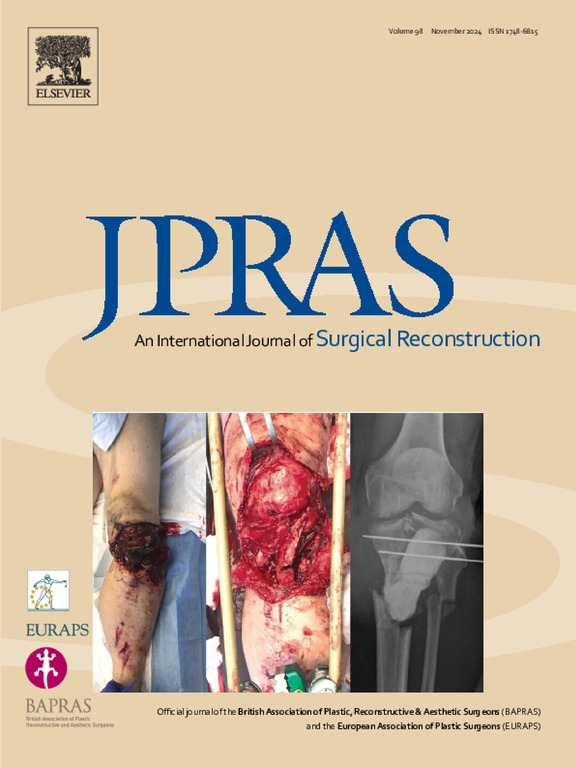既往放疗患者在一期假体乳房重建期间使用ADM的术后并发症:一项国家数据库倾向评分匹配分析
IF 2
3区 医学
Q2 SURGERY
Journal of Plastic Reconstructive and Aesthetic Surgery
Pub Date : 2025-02-25
DOI:10.1016/j.bjps.2025.02.042
引用次数: 0
摘要
脱细胞真皮基质(acellular dermal matrix, ADM)被广泛应用于假体重建以预防包膜挛缩,但其在放疗患者中的安全性尚不清楚。我们的目的是评估在乳房切除术前放疗患者一期假体乳房重建中使用ADM的术后并发症。方法使用2012-2020年的Merative MarketScan研究数据库,通过使用ADM和倾向评分匹配对先前接受过放疗的门诊I期假体乳房重建患者(胸前和肌下)进行分层。采用多因素logistic回归分析90天内的术后并发症和额外手术干预。结果在1234例匹配的患者中(617例ADM和617例非ADM), ADM使用首次记录于2012年,其频率与研究呈正相关(r = 0.214, p <.001)。与非ADM患者相比,ADM患者的伤口发生率(8.5% vs. 7.8%)和组织坏死发生率(5.5% vs. 4.0%)更高,但这些差异无统计学意义。此外,ADM组和非ADM组在血肿、血肿、脂肪坏死或术后感染发生率方面无显著差异。使用ADM与血肿或血清肿需要图像引导液体引流的几率显著降低相关(or 0.11, 95% CI 0.01-0.89, p = 0.039)。结论即使ADM的使用随着时间的推移而增加,接受过大规模放疗的乳腺癌患者的并发症发生率与未接受ADM的患者无显著差异。它的采用应该平衡成本、外科医生的偏好和美学效果,需要进一步研究它在各种重建平面中的作用和成本影响。本文章由计算机程序翻译,如有差异,请以英文原文为准。
Postoperative complications of ADM use in previously irradiated patients during stage I of implant-based breast reconstruction: A national database propensity score-matched analysis
Introduction
Acellular dermal matrix (ADM) is widely used in implant-based reconstruction to prevent capsular contracture, but its safety in irradiated patients is underexplored. We aimed to evaluate postoperative complications associated with ADM use in stage I of implant-based breast reconstruction in patients with premastectomy radiation.
Methods
Using the Merative MarketScan Research Databases, 2012–2020, previously irradiated patients undergoing outpatient stage I implant breast reconstruction (prepectoral and submuscular) were stratified by ADM use and propensity score-matched. Postoperative complications and additional surgical interventions within 90 days were analyzed using multivariate logistic regression.
Results
Among 1234 matched patients (617 ADM and 617 non-ADM), ADM use was first recorded in 2012, and its frequency showed a positive correlation over the study (r = 0.214, p <.001). Patients with ADM experienced higher rates of wound (8.5% vs. 7.8%) and tissue necrosis (5.5% vs. 4.0%) than non-ADM patients, but these differences were not statistically significant. Additionally, no significant differences were observed between ADM and non-ADM groups in the rates of seroma formation, hematoma, fat necrosis, or postoperative infections. ADM use was associated with significantly lower odds of requiring image-guided fluid drainage for hematomas or seromas (OR 0.11, 95% CI 0.01–0.89, p =.039).
Conclusion
No significant difference in complication rates was found between previously irradiated breast cancer patients with and without ADM on a large scale, even with ADM usage increasing over time. Its adoption should balance cost, surgeon preferences, and esthetic outcomes, with further research needed on its role in various reconstruction planes and cost impacts.
求助全文
通过发布文献求助,成功后即可免费获取论文全文。
去求助
来源期刊
CiteScore
3.10
自引率
11.10%
发文量
578
审稿时长
3.5 months
期刊介绍:
JPRAS An International Journal of Surgical Reconstruction is one of the world''s leading international journals, covering all the reconstructive and aesthetic aspects of plastic surgery.
The journal presents the latest surgical procedures with audit and outcome studies of new and established techniques in plastic surgery including: cleft lip and palate and other heads and neck surgery, hand surgery, lower limb trauma, burns, skin cancer, breast surgery and aesthetic surgery.

 求助内容:
求助内容: 应助结果提醒方式:
应助结果提醒方式:


